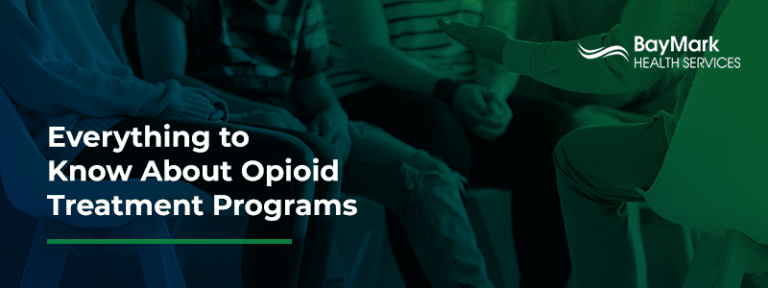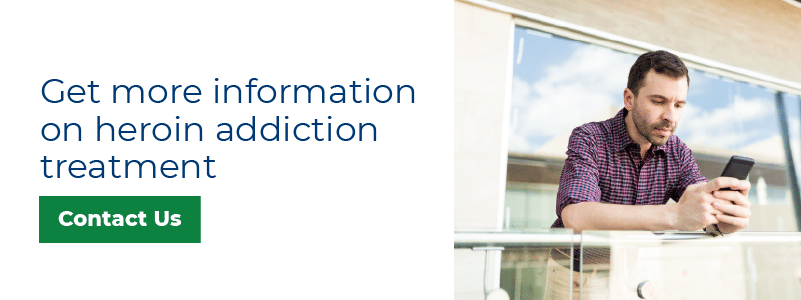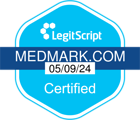When opioid addiction becomes a factor in the life of you or someone you care about, getting help is vital. The right treatment can prevent addiction from destroying health, relationships and finances, but how do you know what the right program is for your needs? It helps to line up the types of treatment options available and match them up to your lifestyle and recovery needs before taking the next steps toward a life free of opioid addiction.
What Is an Opioid Treatment Program?
An Opioid Treatment Program or OTP, is a facility that provides medication-assisted treatment in a highly structured and regulated environment. An OTP seeks to treat someone’s opioid addiction with the use of medications approved by the Food and Drug Administration (FDA). Only OTPs that have received certification from the Substance Abuse and Mental Health Services Association (SAMHSA) can dispense methadone medication-assisted treatment (MAT), the oldest and most commonly used form of MAT.
Medications used in OTPs are designed to block the painful symptoms of opioid withdrawal, allowing the client to stop illicitly using opioids and participate fully in the other elements of the treatment program. The treatment medications currently FDA-approved and available are methadone, buprenorphine and naltrexone.
Methadone is the oldest medication used in OTPs. Researchers originally developed it as a less addictive alternative to morphine, but they quickly found it to be useful in reducing or completely eliminating cravings for heroin. In the early 1970s, the federal government released guidelines for the treatment of addiction with methadone, and people have been successfully completing methadone maintenance treatment (MMT)programs ever since.
Buprenorphine, approved by the FDA in 2002, works similarly to methadone in suppressing and reducing cravings for the opioid of abuse. It is common in formulations that include naloxone, which causes immediate withdrawal symptoms if someone dissolves and injects the medication. While methadone may only be dispensed in a certified OTP, buprenorphine can be dispensed in an OTP, but may also be prescribed by a physician with an appropriate waiver.
Naltrexone is the least common medication of the three, and prevents the person from experiencing any euphoric and sedative effects from opioid abuse.
Medication-Assisted Treatment in Opioid Treatment Programs
OTPs provide outpatient treatment with either methadone or buprenorphine. Methadone is the most popular choice. In an MMT program, clients make daily visits to a methadone clinic and receive their allotted amount of medication each time. Treatment with buprenorphine may require less visits depending on your program, your drug use history and a number of other factors.
With the prevention of withdrawal symptoms, people taking methadone can stop illicitly using opioids without the pain and emotional stress that often leads to relapse. Clients can usually fit outpatient MAT into their school or work schedules, allowing them to get treatment without putting life on hold.
Additionally, OTPs provide individual and/or group counseling to support and develop necessary recovery skills. The combination of supervised medication, psychological services and referrals to local resources equips clients with useful life skills for recovery. Additionally, MAT is also one of the most affordable forms of treatment for opioid addiction.

Other Methods of Opioid Treatment
Although medication-assisted treatment programs have proven to be highly effective, some people find that other types of treatment are beneficial. It’s important to remember that an OTP is a specific type of program using medication-assisted treatment with primarily methadone, and other types of opioid addiction treatment do not fall under the formal definition of certified OTPs created by SAMHSA. Detoxification and residential rehabilitation programs are, however, forms of opioid treatment that can be effective in some cases.
Detoxification
In a detox-focused treatment program, people use medications for only a few days up to a month or so. The medication will block symptoms of withdrawal until the person no longer has the opioid of abuse in their system. Then, the individual tapers off the medication until they aren’t taking any at all.
Many detox programs don’t use MAT in any form. Instead, they focus on removing the drug of abuse from the person’s system using close medical supervision and symptom management without the use of medication. They also may not offer extended support services or the long-term counseling many people need to be successful in recovery. Follow-up and long-term support services should be researched and planned for accordingly.
Residential Rehabilitation
When most people think of addiction treatment, they picture residential or inpatient rehab. These programs require participants to live at the treatment facility — usually for stretches of 30, 60 or 90 days — though there is variation among the many treatment providers. These programs are a good choice for people with histories of overdose, multiple relapses and dual diagnosis with other mental health conditions.
The benefits of residential rehab include close supervision to prevent relapse, as well as the availability of multiple types of therapy and other beneficial activities while in treatment. However, because clients are paying for accommodations as well as treatment itself, residential rehab can end up being financially draining very quickly. Some clients also experience problems transitioning back into their daily lives after the rigorously structured time they spent in rehab.
For the majority of people, MAT at an opioid treatment program is a more appropriate option than either detoxification or residential treatment, as OTPs are more affordable, more effective and offer greater flexibility.
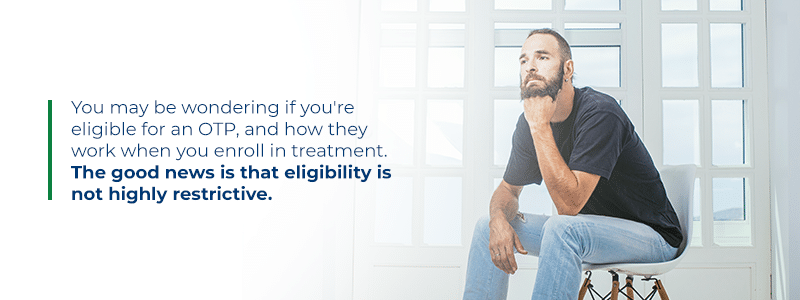
What to Expect at an Opioid Treatment Program
You may be wondering if you’re eligible for an OTP, and how they work when you enroll in treatment. The good news is that eligibility is not highly restrictive. To receive treatment at an OTP, you must:
- Be 18 years of age or older
- Have valid photo identification
- Have opioids as your primary drug of abuse
- Have evidence of opioid addiction
- Agree to follow the policies and procedures of the program
Every OTP is a little different in terms of what intake looks like. Here’s what you can expect at intake with MedMark clinics.
- History review: A doctor or registered nurse (RN) will go over your medical history with you and ask about your background of opioid abuse.
- Physical assessment: Your doctor or RN will perform a physical to get a baseline idea of your health.
- Drug screen: A drug screening will help determine where to start with your medication dosage.
- Counselor consultation: An intake counselor will help you get an idea of what your individualized treatment plan will look like, and answer your questions about treatment.
- Policy review: To ensure you understand and accept the rules, you’ll participate in a review of program policies and procedures.
Once intake is complete, you can start receiving your medication. You’ll pass through three main phases of MAT on your way to recovery.
1. Induction
The induction phase is when you switch from an opioid of abuse to methadone. You will need to arrive at the clinic feeling some withdrawal symptoms. The goal of induction is to find the dose that will alleviate withdrawal symptoms within three to five hours after consumption. Your doctor will keep your medication at the same level for the first three to five days to give it a chance to work.
Induction can be somewhat stressful for some people, as you do have to expose yourself to some withdrawal symptoms before treatment begins. However, the medication will start doing its job within a few hours, and you will begin to feel less symptoms.
2. Stabilization
After the first three to five days, the goal is to adjust the amount of medication you receive until it works reliably. The right dose will allow you to perform regular activities like going to work without feeling intoxicated, sedated or experiencing withdrawal. When finding the right dose, your doctor will make increases of five to 10 milligrams every three to five days.
Mood swings and some drug cravings may accompany stabilization, depending on how long it takes to find your correct dose. Your work in counseling will begin in earnest during stabilization.
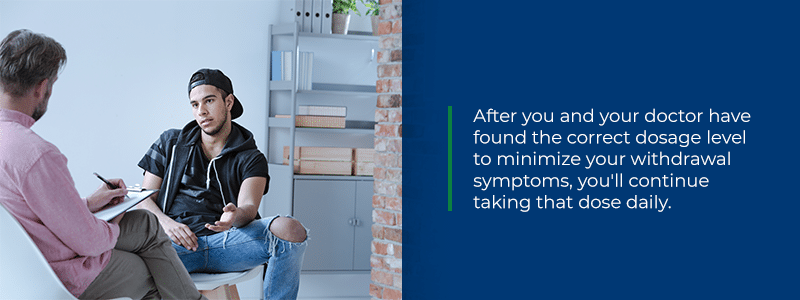
3. Maintenance
After you and your doctor have found the correct dosage level to minimize your withdrawal symptoms, you’ll continue taking that dose daily. The minimum recommendation for treatment duration is 12 months, but some people find the treatment so effective that they continue for multiple years. The longer you successfully participate in your treatment, the more medication you can safely take home. Federal regulations on take-home methadone require:
- Absence of recent drug abuse, including alcohol
- Regular clinic attendance
- Absence of serious behavioral problems at the clinic
- Absence of recent criminal activity
- Stability of home environment and relationships
- Length of time in comprehensive maintenance treatment
- Assurance that you will store your medication safely in the home
- Whether the benefit to the patient outweighs the risk of diversion
Some states are more restrictive than these federal requirements in their allowance of take-home medication.
If you choose to stop taking methadone after a certain period, it’s imperative to consult your doctor. You must carefully taper off methadone to avoid withdrawal and relapse. The process mirrors the induction phase, where your doctor will adjust your dose and observe the effects before making another adjustment.
What About Buprenorphine?
The three phases of treatment are similar for buprenorphine, with a couple of key differences. For one, you must be experiencing a more withdrawal symptoms to begin buprenorphine induction. Buprenorphine has a stronger attraction to opioid receptors than other medications and drugs of abuse, so it can bump them off of the receptors and actual cause more severe withdrawal symptoms immediately.
Additionally, you can take buprenorphine home, meaning that after the induction and stabilization phases, you may only need to visit the clinic twice weekly.
The Importance of Counseling
MAT works because of its two-pronged approach. Addiction develops as a result of both physical and psychological factors, so it makes sense to treat both aspects for a successful recovery. The primary form of counseling is usually individual, where you’ll speak one-on-one with a qualified counselor. Individual counseling addresses these topics.
- Addiction education: Addiction is more complex than many people realize. Taking the time to understand its mechanisms can help change your relationship to drugs of abuse.
- Finding the root cause: Why do people turn to opioid abuse? There are too many reasons to count. Counseling can help you find and address yours.
- Changing behavior: The goal of treatment is to change your responses to stressful situations and cravings. When you identify problematic behavior, you can change it.
Group counseling is also highly beneficial in addiction treatment. Talking with a compassionate group of people who are facing the same challenges you are is essential for maintaining morale and remaining grounded.
Do Opioid Treatment Programs Work?
In short, yes. The American Society of Addiction Medicine recognizes MAT as the most effective treatment for opioid use disorder. It is more effective than behavioral intervention and medication alone, and significantly reduces the illicit use of opioids as compared to approaches that do not use medication. However, you should remember addiction does not have a “cure.”
Many people are familiar with the idea of addiction as a disease, but don’t realize it resembles a chronic condition like diabetes, instead of a curable illness like the flu. No one can enter treatment and come out completely free of all temptation to use opioids. Rather, treatment offers a set of tools — including medications — that allow for successful management of the condition, much like how insulin enables people with diabetes to maintain their blood sugar. By this definition, OTPs are highly effective.
Part of the problem is that there is no reliable metric for measuring the effectiveness of opioid treatment programs. Some of the most commonly used ones include:
- Completion of a treatment program
- Rates of sobriety in the weeks or months following treatment
- Interviews with clients
- Internally conducted studies
Understandably, these metrics do not provide clear insight into whether an OTP “worked” or not. It is crucial to understand that relapse does not indicate failure. While any client’s goal is to remain sober permanently, relapse is a possibility. Treatment is successful when it teaches people with addiction how to manage their condition effectively and reduce the possibility of relapse. MAT is much more effective at this than any other form of opioid addiction treatment.
Quality MAT at MedMark
Opioid addiction is a dangerous state that requires immediate treatment to avoid serious financial, psychological and physical harm. Finding the right treatment program is the best way to increase your chances of a successful recovery, and MedMark is here to help. You may be wondering: Does MedMark have opioid treatment programs near me? Our clinic locator will help you find out if one of our 34 locations is in your area.
MedMark has been offering evidence-based MAT for more than 10 years. Our focus on client care and customer service has helped us expand to help thousands of people like you since our foundation. If you’re ready to learn more about our opioid treatment programs, we invite you to reach out with a phone call to 866-840-6658 or get in touch via our contact form. Recovery can start today.

